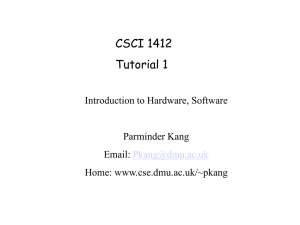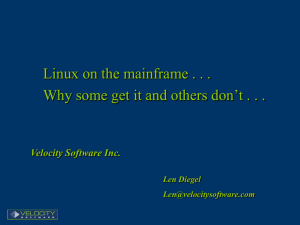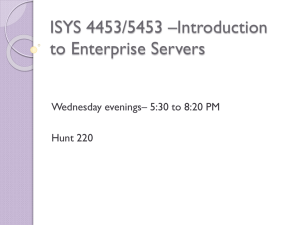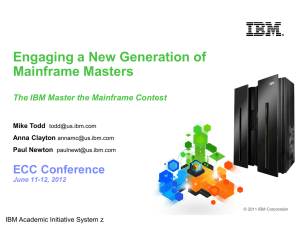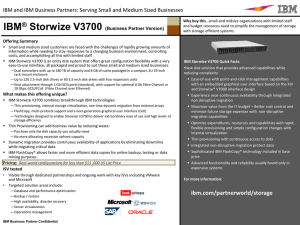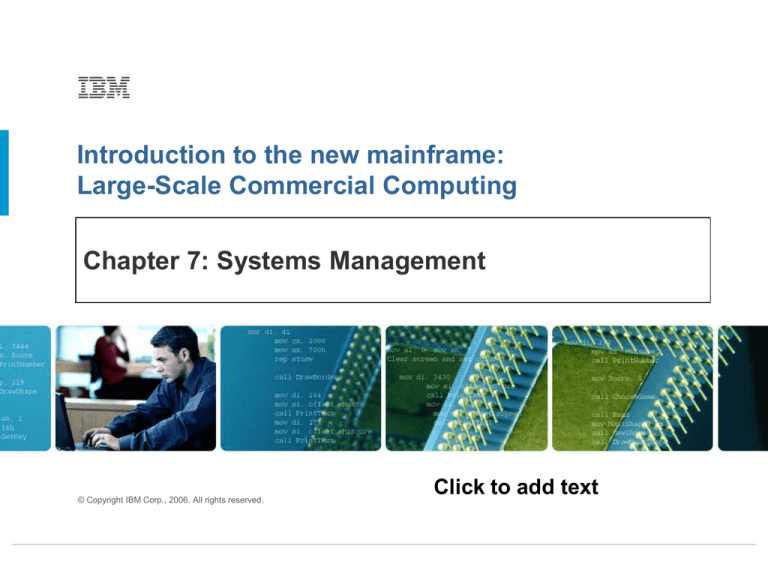
Introduction to the new mainframe:
Large-Scale Commercial Computing
Chapter 7: Systems Management
© Copyright IBM Corp., 2006. All rights reserved.
Click to add text
Introduction to the new mainframe
Objectives
Be able to:
• Understand system management disciplines
• Understand the different data types z/OS uses
• Understand how errors are handled
© Copyright IBM Corp., 2006. All rights reserved.
2
Introduction to the new mainframe
Introduction to systems management
Systems management is a general term that is widely used, .
Sometimes it means:
- the operator interface,
- means provisioning capacity.
In a large-scale commercial system,
“A collection of disciplines aimed to monitor and control a
system’s behavior.”
© Copyright IBM Corp., 2006. All rights reserved.
3
Introduction to the new mainframe
Introduction to systems management
Performance management
Workload management
Configuration management
Operations management
Problem management
Network management
Storage management
Security management
Change management
© Copyright IBM Corp., 2006. All rights reserved.
4
Introduction to the new mainframe
System Data
Accounting
Reporting
• Performance
• Errors
© Copyright IBM Corp., 2006. All rights reserved.
5
Introduction to the new mainframe
Z/OS component SMF (System Management Facilities)
Collect info concerning:
Billing users
Reporting reliability
Analyzing the configuration
Scheduling jobs
Summarizing direct access volume activity
Evaluating data set activity
Profiling system resource use
Maintaining system security
© Copyright IBM Corp., 2006. All rights reserved.
6
Introduction to the new mainframe
Data Collection in z/OS
Routines(SMF,
system, product,
installation-written)
collect andformat
dataintorecords
andthenpassthe
recordstotheSMF
writer
RoutinesProviding
Data toSMF
SMFW
riter
Routinesand
Buffers
SMF
Data
sets
Dump
data
set
User-written
Analysis/Report
Routines
© Copyright IBM Corp., 2006. All rights reserved.
7
Introduction to the new mainframe
WorkLoad Management (WLM)
WLM retains the following data:
CPU time used
Memory used + pages/sec
I/Os done + I/O rate
Transaction rate
Goal achievement
© Copyright IBM Corp., 2006. All rights reserved.
8
Introduction to the new mainframe
Performance management
Performance management includes measuring, analyzing,
reporting, and tuning the performance of IT resources.
Two categories:
Real-time monitoring, alerting, problem identification, and
problem resolution...What's happening NOW
Bench marking, modeling, rerunning problem scenarios,
and trending performance metrics to feed capacity
planning...Where are we heading
© Copyright IBM Corp., 2006. All rights reserved.
9
Introduction to the new mainframe
Performance management
Objectives:
Optimize response time and throughput of IT resources
Take corrective actions to alerts and problem requests
© Copyright IBM Corp., 2006. All rights reserved.
10
Introduction to the new mainframe
Performance management : z/OS implementation
Resource Measurement Facility (RMF):
Batch monitoring
CPU
Storage
Workload
I/O Activity
Other
Online monitoring
Delay monitoring ...Queue wait time
© Copyright IBM Corp., 2006. All rights reserved.
11
Introduction to the new mainframe
Configuration management
In a large-scale commercial system,
- the number of hardware devices,
- system software items (compiled modules, source
modules, data items, etc.), and
- application software items have been large since the
first days of the mainframe.
© Copyright IBM Corp., 2006. All rights reserved.
12
Introduction to the new mainframe
System Software configuration management
Characteristics:
Large number of components.
Great packing flexibility.
Backward compatibility need.
Different software developers and vendors.
Long-supported versions.
© Copyright IBM Corp., 2006. All rights reserved.
13
Introduction to the new mainframe
System Software configuration management
4 types of SYSMODs:
PTF
APAR
FUNCTION
USERMOD
© Copyright IBM Corp., 2006. All rights reserved.
14
Introduction to the new mainframe
Hardware configuration management
Hardware Configuration Definition (HCD) :
It is written in a system file.
Is split between the hardware and the software.
Has to be tested.
Has to be activated sysplex-wide
© Copyright IBM Corp., 2006. All rights reserved.
15
Introduction to the new mainframe
Application configuration management
Application configuration management is a discipline that is
common to any platform.
On a IBM System z platform these tools must be able to
manage Java (WebSphere Application Server) as well as
COBOL applications.
IBM’s tool is named Software Configuration and Library
Manager (SCLM).
© Copyright IBM Corp., 2006. All rights reserved.
16
Introduction to the new mainframe
Operations management
Operations in a large-scale commercial operating system is
crucial for performance and availability.
Operations means 2 related activities:
Batch scheduling
Console operations
© Copyright IBM Corp., 2006. All rights reserved.
17
Introduction to the new mainframe
Problem management
Problem management is a discipline that can be viewed from various
angles:
How problems are solved
How problems are reported
How problems are tracked
© Copyright IBM Corp., 2006. All rights reserved.
18
Introduction to the new mainframe
Network management
z/OS participates as any other node on the network and
complies to the standards in this area
On such networks, the z/OS network management subsystem
usually acts as the focal point.
© Copyright IBM Corp., 2006. All rights reserved.
19
Introduction to the new mainframe
Storage management
In z/OS the software that manages the external storage devices
is called DFSMS. (Data Facility Storage Management
Subsystem)
© Copyright IBM Corp., 2006. All rights reserved.
20
Introduction to the new mainframe
Security management
Legend
Intrusion
Detection
System
BtB
Users
Policy
Manager
INTERNET
Policy
Director
Manage
r
WebSeal
TIVOLI
SecureWay Directory
Switch
INTRANET
WebSeal
WebSeal
Switch
...
IDS
LPAR
DMZ Internet
IBM System z
FireWall
LPAR
DMZ Internet
LPAR
DMZ Internet
FireWall FireWall
Web Services Web Services Web Services
Users
Production LPAR
VPN
© Copyright IBM Corp., 2006. All rights reserved.
21
Introduction to the new mainframe
Change management
Change management is a discipline that is
-meant for the whole infrastructure.
-z/OS manages changes applied to software
through SMP/E asking for prerequisites and logging
the changes.
© Copyright IBM Corp., 2006. All rights reserved.
22
Introduction to the new mainframe
Summary
9 system management disciplines
Service Level management (SLA) is not covered
Security management is special
Tools are available
© Copyright IBM Corp., 2006. All rights reserved.
23

